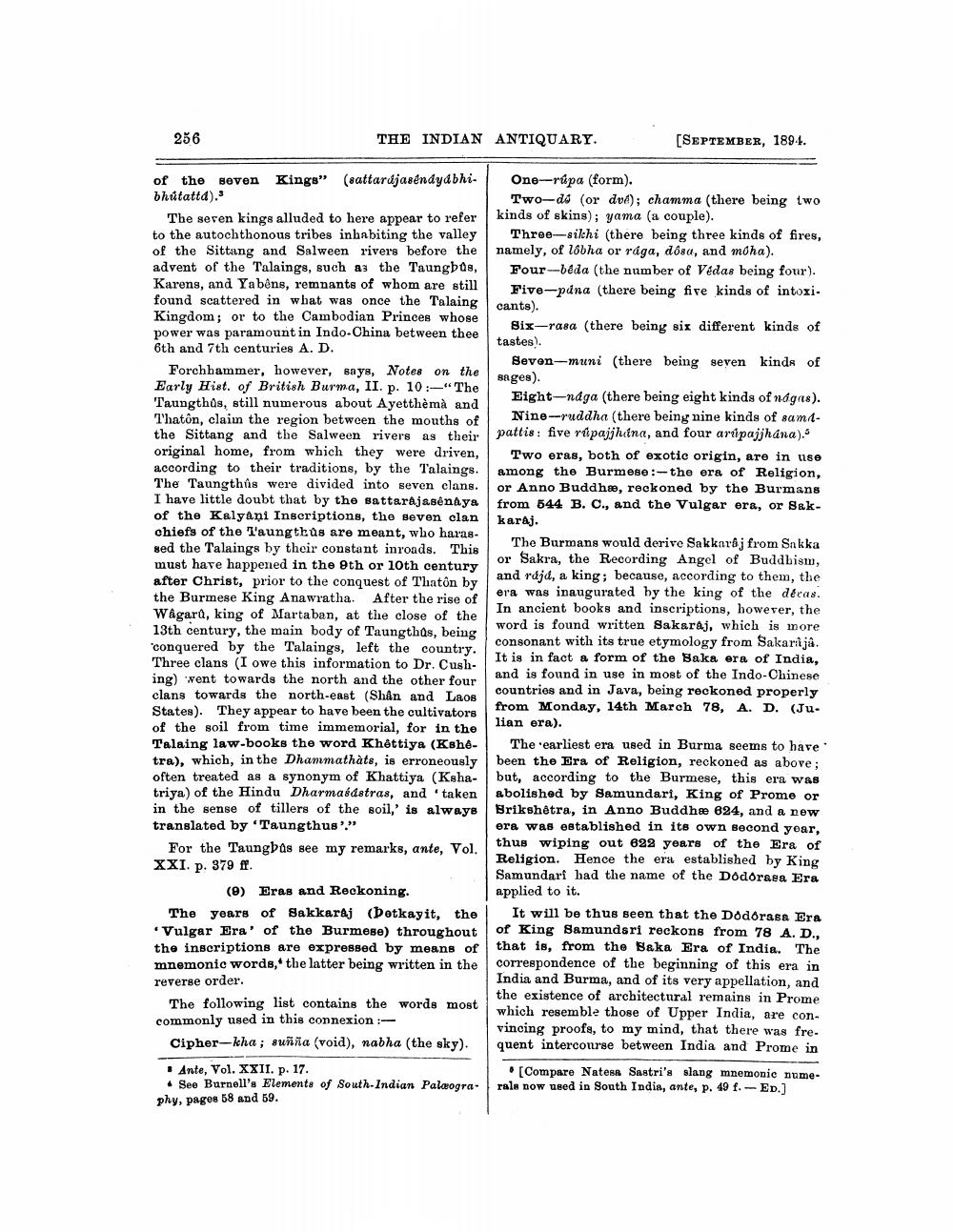________________
256
THE INDIAN ANTIQUARY.
[SEPTEMBER, 1894.
of the seven Kings" (sattarújasendyabhi. One-rúpa (form). bhútattd).'
Two-de (or dvd); chamma (there being two The seren kings alluded to here appear to refer
kinds of skins); yama (a couple). to the autochthonous tribes inhabiting the valley Three-sikhi (there being three kinds of fires, of the Sittang and Salween rivers before the namely, of lobha or rága, dosa, and móha). advent of the Talaings, such as the Taungbos, Four-beda (the number of Vedas being four). Karens, and Yabéns, remnants of whom are still
Five-puna (there being five kinds of intoxi. found scattered in what was once the Talaing
cants). Kingdom; or to the Cambodian Princes whose
Six-rasa (there being six different kinds of power was paramount in Indo-China between thee
tastes). 6th and 7th centuries A. D.
Seven-muni (there being seven kinds of Forchhammer, however, says, Notes on the
sages). Early Hist. of British Burma, II. p. 10 :-"The Taungths, still numerous about Ayetthèmà and
Eight-ndga (there being eight kinds of nagas). Thatôn, claim the region between the mouths of
Nine-ruddha (there being nine kinds of samtthe Sittang and the Salween rivers as their
and the Salween rivers as their pattis : five rapajjhina, and four artpajjhana). original home, from which they were driven, Two eras, both of exotic origin, are in use according to their traditions, by the Talaings. among the Burmese :- the era of Religion, The Taungthûs were divided into seven clans. or Anno Buddha, reckoned by the Burmans I have little doubt that by the battarajasenaya
from 544 B. C., and the Vulgar era, or Bakof the Kalyani Inscriptions, the seven clan
karaj. chiefs of the Taungthus are meant, who harassed the Talaings by their constant inroads. This
The Burmans would derive Sakkaraj from Snkka must have happened in the 9th or 10th century
or Sakra, the Recording Angel of Buddhism, after Christ, prior to the conquest of Thatôn by
and rajd, a king; because, according to them, the the Burmese King Anawratha. After the rise of
era was inaugurated by the king of the déras. Wagara, king of Martaban, at the close of the
In ancient books and inscriptions, however, the 13th century, the main body of Taungthus, being
word is found written Sakaraj, which is more 'conquered by the Talaings, left the country.
consonant with its true etymology from Sakarija. Three clans (I owe this information to Dr. Cush
It is in fact a form of the Baka era of India, ing) went towards the north and the other four
and is found in use in most of the Indo-Chinese clans towards the north-east (Shân and Laos
countries and in Java, being reckoned properly States). They appear to have been the cultivators
from Monday, 14th March 78, A. D. (Ju. of the soil from time immemorial, for in the
lian era). Talaing law-books the word Khêttiya (Kshe- The earliest era used in Burma seems to have tra), which, in the Dhanmathats, is erroneously been the Era of Religion, reckoned as above; often treated as a synonym of Khattiya (Ksha- but, according to the Burmese, this era was triya) of the Hindu Dharmafdstras, and taken abolished by Samundari, King of Prome or in the sense of tillers of the soil,' is always Brikshetra, in Anno Buddha 824, and a new translated by 'Taungthus'."
era was established in its own second year, For the Taungbas see my remarks, ante, Vol.
thus wiping out 622 years of the Era of
Religion. Hence the era established by King XXI. p. 379 ff.
Samundarf had the name of the Dodoraea Era (0) Eras and Reckoning.
applied to it. The years of Sakkaraj (Potkayit, the It will be thus seen that the Dodbraba Era • Vulgar Era' of the Burmese) throughout of King Samundsri reckons from 78 A. D.. the inscriptions are expressed by means of that is, from the Baka Era of India. The mnemonic words, the latter being written in the correspondence of the beginning of this era in reverse order.
India and Burma, and of its very appellation, and
the existence of architectural remains in Prome The following list contains the words most
which resemble those of Upper India, are concommonly used in this connexion :
vincing proofs, to my mind, that there was fre. Cipher-kha; suñña (void), nabha (the sky). quent intercourse between India and Prome in • Ante, Vol. XXII. p. 17.
(Compare Natesa Sastri's slang mnemonic nume* See Burnell's Elements of South Indian Palaogra- rale now used in South India, ante, p. 49 f. -ED.] phy, pages 58 and 59.




